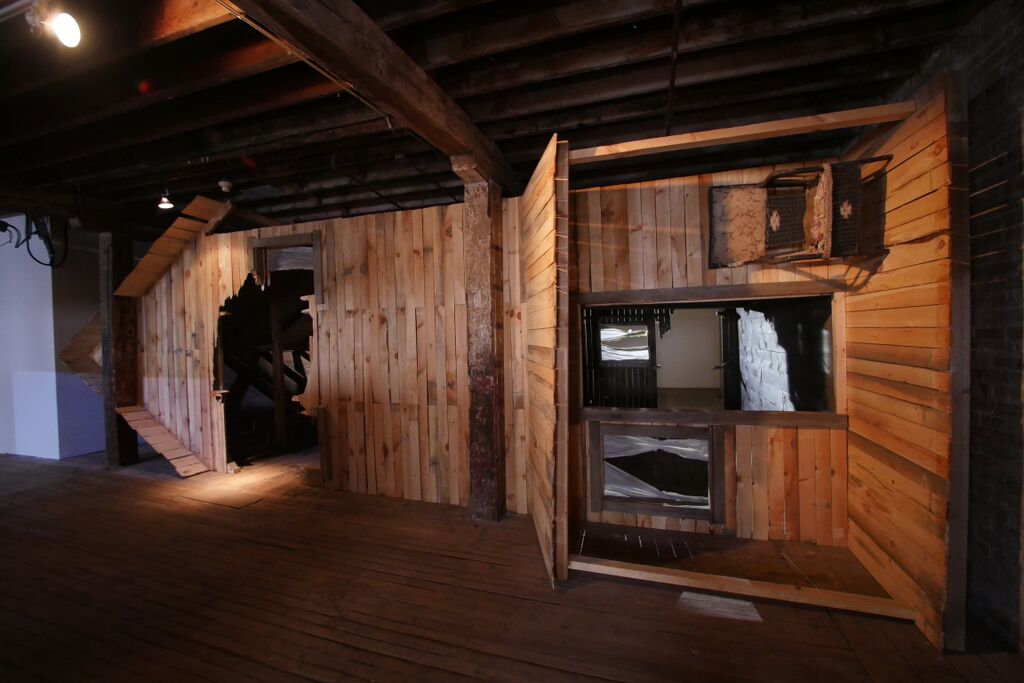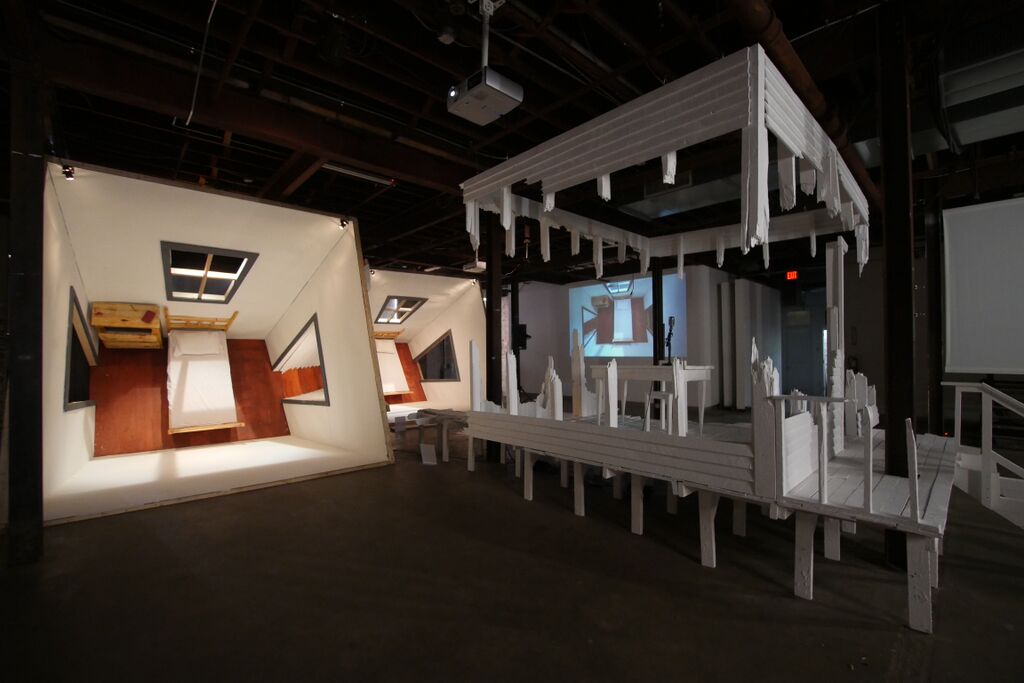Tell It Slant
The elegant decay of both the setting and characters in Flannery O'Connor's novel, Wise Blood, provide an ideally damaged environment for artist Chris Larson's distinctive aesthetic twists in the operatic adaptation-cum-exhibition based on the book, made in collaboration with composer Anthony Gatto

“Does one’s integrity lie in what he is not able to do?” Flannery O’Connor asks in the preface to the 1962 version of her debut novel Wise Blood. This question sets up her defense of the novel’s role to deepen, not simplify, the mystery of freedom. Her story’s protagonist, war veteran Hazel Motes, moves to the fictional Tennessee town of Taulkinham where he publicly denounces Jesus in favor of a sort of antireligion, his “church of Christ without Christ,” in order to become free from his tortured religious upbringing.
And recently, 63 years after O’Connor first introduced Motes to the world, he has been revived in Minneapolis as a lively singer, played by Martin Bakari, in The Soap Factory’s operatic adaptation of Wise Blood.
Read a novel, and the narrative unfolds at the pace of the individual reader — you can pause, put the book down in contemplation, throw it at the wall, reread beloved passages. You may finish a book in one sitting or over the course of a month. You might hate it at first but then grow to love it years later. That’s how a novel, especially one as layered and conflicted as Wise Blood, usually lives in the world. An opera, on the other hand, is best experienced in performance, and on the stage everything comes readymade for the viewer — from set design to costumes to mood.
In this dramatic retelling of O’Connor’s story, those two separate spaces — the private psychological realm of the reader and the operatic environment fabricated for the stage — are conflated. In the audience, we are as if ghostly spectators shuffling through the reader’s mind – or minds, as the case is here. Our readers by proxy for this unusual production of Wise Blood are St. Paul visual artist, Chris Larson, and Brooklyn composer, Anthony Gatto.

They’ve worked together like this before. Many moons ago, Larson and Gatto were roommates at Yale, where they each pursued graduate degrees, in visual art and music composition respectively. In 2008, they collaborated on an operatic version of Gertrude Stein’s The Making of Americans for the Walker Art Center. Indeed, there’s a rich tradition of visual and performance artists conspiring to revive works of literature in this way. In the last 20 years, this sort of cross-pollination has become especially experimental, in terms of both play with traditional dramatic structure (like breaking down the “fourth wall”) and adding in various new media. W.G. Sebald has a cult-like following for such projects. Poet Anne Carson combines readings with dancers’ responses to the texts. (If you find yourself in New York, you can catch the ultimate immersive, literary theater experience: Punchdrunk’s popular production of Sleep No More.)
The recent show at the Soap Factory may have been a joint-venture, but Larson’s set design, vividly evocative of O’Connor’s “grotesque” South, serves as the cornerstone of this take on Wise Blood. The textile mill villages and scrappy, plantation plain-style houses of the mid-20th century landscape determined the aesthetic that Larson, then, goes on to deconstruct. As a standalone exhibit, his stage set looks like an abandoned town, ravaged by some demonic force that has turned it inside out.

Larson is legendary locally for rebuilding a full-scale replica of the house Marcel Breuer designed in 1954 for St. Paul artist-monk Frank Kacmarcik, only to set it on fire during the 2013 Northern Spark. For the Wise Blood project, he was likewise drawn to the architecture in O’Connor’s literature. For a sculptor who destroys buildings (after he builds them to perfection), the novel provides a template for an ideally damaged environment. O’Connor’s structures slowly sag, creak, and dilapidate until they cave in completely— an ongoing dissolution manifest in her characters as much in as her Southern Gothic settings. And Larson has twisted those structures, literally turning the constructed rooms on their sides. For example, the beds are hinged upright on the walls; characters lean against them to give the impression they are supine. He has transformed the novelist’s set pieces into sculptural canvases, artworks that actors may enter and exit as the opera’s action unfolds. This shift enables the audience to watch everything from a kind of aerial, god-like perspective. Within the context of a religious story about redemption, exploitation, and anxiety, it is nothing short of genius to create a set that directly implicates the audience in this way, making plainly visible the watchers’ omniscient, but twisted, view on the unfolding drama.
While Wise Blood seems to be more about seeing than hearing, Gatto’s libretto is also a noteworthy amalgam: among the many influences in the music, I recognized the distinctive sound of Southern brass bands (provided by the Adam Meckler Orchestra), George Antheil (a personal favorite), burial hymns, and even Wilco. (I had a head-scratching moment when Martin Bakari, as Hazel Motes, began to sing O’Connor’s words to Wilco’s melody from “Hell is Chrome” until I remembered the original lyrics — when the devil came he was not red, he was chrome; the secondary allusion, to following the devil into Hell, seems particularly fitting.)

Impressive as it is, there’s a certain stiffness in this revival of O’Connor’s novel. With so many moving parts in both the book and the production, some elements simply don’t translate neatly from one medium to the other. And unfortunately, the odd parts tend to stick out. Between the flurry of hard-sell evangelists each aiming to out-preach the others, the high pathos of plainly Oedipal tropes, and lofty philosophical ruminations, the drama on stage is so relentlessly urgent as to feel contrived. Everyone is lost, lonely, and on the brink of insanity — but they are also, so obviously, actors. As affecting and creepy as the characters could be (especially Zoo Animal’s Holly Hansen as Sabbath Lily Hawks), it was difficult to feel intimately connected to their stories while moving through the production as part of a roving, silent audience looking on.
And it’s that sense of emotional immediacy that struck me as I read O’Connor’s novel. I was haunted by Hazel Motes’ anguish in remembering how, in his youth, “Jesus moved from tree to tree in the back of his mind, a wild ragged figure motioning him to turn around and come off into the dark where he might be walking on the water and not know it and then suddenly know it and drown.” Despite the “wow factor” of Larson/Gatto’s ambitious, multidisciplinary re-imagining of Wise Blood, it is still hard to beat the world I could conjure in my mind with O’Connor’s words alone.
Related information: Wise Blood, copresented and co-comissioned by Walker Art Center, is on view at the Soap Factory in exhibition form May 9 to June 21; on-site performances of the opera ran June 4 through 14, 2015.